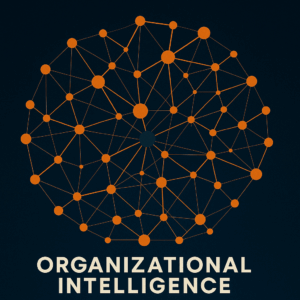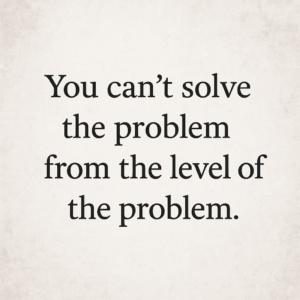How Type 1 and Type 2 Thinking Powers Scalable AI-Human Collaboration
Summary Insight:
If you want to scale AI inside your company without introducing chaos, you need to do more than “implement tools” — you need to design governance systems that clearly define who makes what kind of decision and how.
The best way I know to do this is by applying Type 1 vs. Type 2 decision-making and the 3 Agreements. These frameworks give you a structure for distributing authority between humans and AI agents in a way that increases execution speed, preserves accountability, and lowers entropy as your organization scales.
Key Takeaways:
- Structure, not tech, is the bottleneck. Most companies aren’t struggling with AI tools—they’re struggling with unclear governance and decision rights.
- Use Type 1 vs. Type 2 thinking. Teach your team to distinguish between irreversible strategic decisions (Type 1) and fast, reversible ones (Type 2) to unlock speed and clarity.
- Adopt the 3 Agreements. With AI in the loop, scalable governance comes from shared decision-making norms—not more policies or rigid rules.
Why Governance — Not Technology — Is Your Real Bottleneck
Most companies aren’t struggling with AI tools. The tools are here. They’re getting better by the week.
What companies are struggling with is governance:
- Who makes which decisions?
- What do we automate vs. delegate vs. own?
- How do we avoid shadow processes and permission paralysis?
Left unclear, these questions lead to confusion, duplication, and low-trust cultures — exactly the kind of entropy that kills momentum in scaling businesses.
So here’s the answer: don’t build more rules or policies.
Instead, build decision-making agreements based on principles.
The Core Framework: Type 1 vs. Type 2 Decisions
Not all decisions are created equal — and if you treat them the same way, you’re going to slow down execution or crash the ship.
From Designed to Scale, using the Amazon metaphor of decisions as one-way or two-way doors, I define:
- Type 1 decisions as one-way doors — hard to reverse, strategically significant, with high consequences. These must go through your Strategic Execution Team (SET).
- Type 2 decisions are two-way doors — reversible, operational, and lower risk. These are owned by individuals, not committees.
Your job as CEO is to teach your culture to ask and clarify upfront:
“Is this a Type 1 or a Type 2 decision?”
Once that’s clear, you can structure human-AI collaboration accordingly.
The 3 Agreements: A Governance Layer for Human + AI Decision Rights
When you combine Type 1/Type 2 thinking with the 3 Agreements, you create a governance framework that scales — no matter how much AI you introduce.
Agreement #1: The SET makes cross-functional Type 1 decisions
These are your most important decisions. They’re strategic, cross-functional, and require the full clarity and buy-in of your SET. With AI in the mix, here’s how this plays out:
- AI agents can inform decisions (data synthesis, modeling, forecasting).
- Humans still own the decision and must bring proposals to the table — in writing, not Power Point, using the Type 1 Proposal Template.
- Proposals must be accepted by the implementer, not assigned top-down.
AI can enhance the input, but you still need human judgment to make irreversible choices.
Agreement #2: Everyone seeks perspective and accepts accountability for their role(s)
This governs Type 2 decisions — everyday execution.
When assigning these to AI systems:
- You must define where AI has operational authority (e.g., routing tickets, adjusting pricing within bounds).
- The human responsible for the outcome must still seek perspective and own downstream impacts.
- AI is not a scapegoat. It’s an agent executing decisions that humans remain accountable for.
This agreement ensures you don’t end up with a bunch of automation islands no one understands or controls.
Agreement #3: We commit to listen, understand, decide, and act
Once a decision is made — whether by a human or in coordination with AI — it’s time to move.
In an AI-native org, this means:
- AI-generated insights or actions are treated as legitimate — not ignored because they didn’t come from a VP.
- But humans have the final veto on whether to implement a course correction if it crosses a threshold of risk.
This agreement supports the cultural norm of “disagree and commit” — which is vital when AI is surfacing answers faster than your comfort zone allows.
AI Governance in Practice: What Gets Delegated to AI?
Here’s a practical breakdown you can use today:
| Decision Type | Owner | Role of AI | Execution Rule |
| Type 1 (one-way door) | SET | Insight, modeling, simulation | Proposals in writing, reviewed and accepted |
| Type 2 (two-way door) | Individual or team | Action, automation, optimization | Seek perspective → execute → iterate |
| Operational rule | System | Fully automated | Clear thresholds, audits, fallbacks |
Over time, Type 2 decisions can be safely delegated to AI agents — as long as your team is trained to:
- Know when to seek perspective
- Know who is downstream
- Know what to escalate back to Type 1
That’s governance. That’s alignment. That’s what allows you to scale.
Final Thought: Structure Is the Strategy
In the AI era, everyone’s buying the same tools. The differentiator isn’t access — it’s structure.
Your structure must:
- Define who decides what
- Enable reversible decisions to flow fast
- Prevent strategic decisions from becoming consensus sludge
- Assign real accountability to AI-enabled workflows
- Reinforce cultural principles, not policies
This isn’t theoretical. I’ve seen organizations go from bogged-down to high-velocity by adopting the 3 Agreements and embedding Type 1/Type 2 thinking across teams.
With AI in the mix, these frameworks become even more critical.
Because you’re not just building a company that can use AI.
You’re building a company that can govern AI — without losing speed, trust, or control.
And that starts with how you make decisions.




